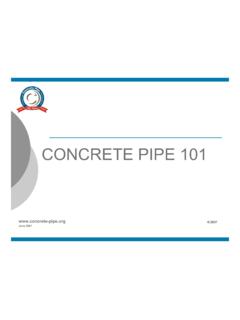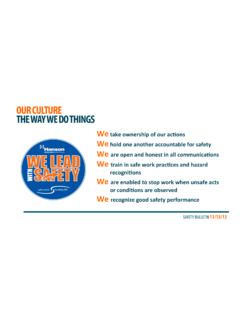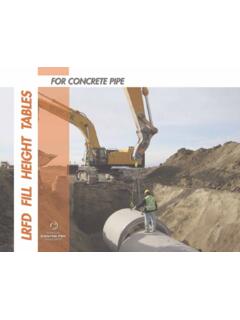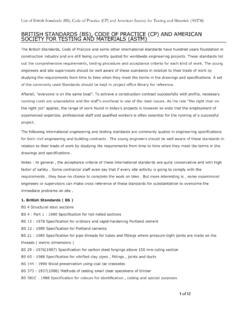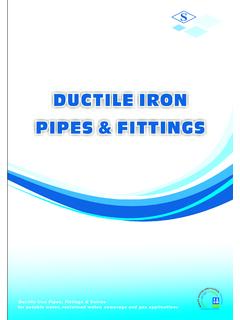Transcription of CONCRETE PIPE JOINTS, YOUR BEST CHOICE
1 pipe JOINTS, YOUR BEST CHOICE CONCRETE pipe JOINTS, YOUR BEST CHOICE Q. Are joints covered by National Standards?A. Yes. There are ASTM and AASHTO standards for CONCRETE products joints. The various standards are discussed in this publication. The versatility of joints allows the designer to match project requirements with the appropriate joint and/or seal. Note that joints for most pipe products are specified in separate standards than the pipe and precast manufacturing and design standards. Q. What is the advantage of a CONCRETE pipe joint ?A. Besides the inherent strength of CONCRETE pipe , a CONCRETE pipe joint can be designed to provide soil-tightness or water-tightness, with the ability to accommodate lateral or longitudinal movement by using several joint options including mortar, flexible joint sealants, rubber gaskets and external sealing Is there a field test to verify CONCRETE pipe joint design?A. Yes.
2 There are four different field test methods to verify CONCRETE pipe joint design, for vacuum, air or water. ASTM C 924 Standard Practice for Testing CONCRETE pipe Sewer Lines by Low-Pressure Air Test Method covers testing of 4 to 24-inch CONCRETE pipe sewer lines using the low-pressure air test method to demonstrate the integrity of the joint . ASTM C 1103 Standard Practice for joint Acceptance Testing of Installed Precast CONCRETE pipe Sewer Lines provides procedures for acceptance testing of joints by air or water tests of installed CONCRETE pipe joints. ASTM C 969 Standard Practice for Infiltration and Exfiltration Acceptance Testing of Installed Precast CONCRETE pipe Sewer Lines covers procedures for testing installed CONCRETE pipe sewer lines using water infiltration or exfiltration acceptance limits to demonstrate the integrity of the joints. ASTM C 1214 Standard Test methods FREQUENTLY ASKED QUESTIONSfor CONCRETE pipe Sewer Lines by Negative Air Pressure (Vacuum) Test Method covers procedures for testing 4 to 36-inch CONCRETE pipe sewer lines using the vacuum test Are joints from alternate materials equivalent in performance to CONCRETE pipe joints?
3 A. The use of a rubber gasket does not by itself ensure that different joint types are equal. Designers can utilize ASTM Standards to specify for desired performance but in the case of alternate materials, additional guidance may be required. CONCRETE pipe joints are governed, in national standards, by better, more detailed designs with tighter tolerances and higher test pressures. Additionally, the project owner benefits from the CONCRETE pipe joints inherent strength and rigid pipe design to enhance line and grade and assurance against deflection and Based Rubber gasketed CONCRETE pipe joints meet the stringent requirements of ASTM C 2009 American CONCRETE pipe Association, all rights reserved. Resource # e-07-124 (07/09)oncrete pipe , in one form or another, has been used for various purposes since the earliest days of civilization. In North America, CONCRETE pipe has been used extensively in drainage and sanitary sewer systems since the 19th century.
4 Technology advancements in industry over the last century have led to major improvements in the CONCRETE pipe manufacturing processes, mix designs, strength, reinforcement, and installation designs. One area that has continued to evolve and progress, along with the rest of the CONCRETE pipe industry, is joint design and production. Today s CONCRETE pipe offers several types of joints that meet stringent industry and national standards for function of a pipeline generally determines the performance requirements of the pipe joints. Whether the purpose is to convey sanitary sewage or storm water, joints are designed so that when sections are laid together they will make a continuous line of pipe with an interior free from irregularities. Joints can be designed to provide soil-tightness, or watertightness, with the ability to accommodate lateral or longitudinal movement, and strength to handle shear or vertical pipe manufacturers have developed joint designs to provide the following performance characteristics: Resistance to infiltration of groundwater and backfill material Resistance to exfiltration of sewage or storm water Ability to accommodate lateral or longitudinal movement Strength to handle shear or vertical movement Pipeline continuity and smooth flow line Allow infiltration of groundwater for subsurface drainage Ease of installationIn addition to the advantages of the CONCRETE pipe joints mentioned above, the increased number of joints, typically marketed by competing products as a perceived shortcoming of CONCRETE pipe , may in fact be an advantage for many installations.
5 With an increased number of joints: line and grade is maintained and checked more frequently, pipe lengths can fit and be positioned in standard trench boxes more easily, and longitudinal stresses in pipe walls are relieved when pipelines encounter non-uniform bedding CONCRETE pipe industry offers several joint systems to satisfy this broad range of performance requirements. Consultation with local CONCRETE pipe manufacturers will provide information on the availability of the various pipe JOINTS, YOUR BEST CHOICED esign Versatility CONCRETE pipe comes in the shape, size and joint configuration for virtually any drainage # e-07-124 (07/09) 2009 American CONCRETE pipe Association, all rights reserved. Precast CONCRETE pipe joints are manufactured in two basic shapes: Tongue and groove Bell and spigotConcrete surfaces with opposing shoulders on both ends, such as the bell and spigot joint , generally utilize a rubber gasket for sealing.
6 Preformed flexible joint sealants or mortar are used for lesser performance requirements or where the product shape dictates the type of Rubber Gasket JointsConcrete joints with a groove or offset on the spigot and/or bell utilize a rubber gasket, which fits against the shoulder or in the groove of the joint . Rubber gasketed CONCRETE pipe joints are frequently used where measurable infiltration/exfiltration and/or internal pressure is a factor in the design. This joint combines great shear strength, excellent watertightness and flexibility. There are a wide variety of rubber gasket joints from which to choose, but they must meet certain stringent requirements included in either ASTM C 443 Standard Specification for Joints for Circular CONCRETE Sewer and Culvert pipe , Using Rubber Gaskets, ASTM C 361 Standard Specification for Reinforced CONCRETE Low-Head Pressure pipe or ASTM C 1628 Standard Specification for Joints for CONCRETE Gravity Flow Sewer pipe , using Rubber Preformed Flexible joint SealantsBitumen and butyl sealants are manufactured in accordance with ASTM C 990 Standard Specification for Joints for CONCRETE pipe , Manholes, and Precast Box Sections Using Preformed Flexible joint Sealants.
7 The sealant is applied to the tongue or spigot and inserted into the bell or groove. Joints utilizing flexible mastic sealants typically perform as a soil-tight system unless higher performance expectations are CONCRETE pipe joint SYSTEM OPTIONST ypical cross-section of tongue and groove joint with flexible mastic cross-section of opposing shoulder type bell and spigot joint with a confined o-ring rubber cross-section of opposing shoulder type bell and spigot joint with a single offset rubber and Performance CONCRETE pipe joints accommodate movement and horizontal and vertical 2009 American CONCRETE pipe Association, all rights reserved. Resource # e-07-124 (07/09)described in the project specifications. If properly applied, these joints provide a degree of flexibility without impairing watertightness. However, they are not intended to perform under internal Mortar Tongue and GrooveFor mortar joints, a layer of cement paste or mortar is placed in the lower portion of the bell or groove of the installed pipe and on the upper portion of the tongue or spigot of the pipe section to be installed.
8 The tongue or spigot is then inserted into the bell or groove of the installed pipe until the sealant material is squeezed out onto the interior or exterior surfaces. Joints employing mortar joint sealants are rigid. Mortar joints have been used successfully as a soil-tight joint for many External Sealing BandsExternal flexible sealing bands are produced to ASTM C 877 Standard Specification for External Sealing Bands for CONCRETE pipe , Manholes and Precast Box Sections and are designed to be wrapped around the exterior of the joint to provide resistance to infiltration and/or DiscussionDesign engineers need to be aware of what is and is not included within suggested pipe standards for their projects. When comparing the performance of pipe jointing systems between CONCRETE pipe and alternate products, one should review the standard specifications of each product. Two of the bodies most often referred to are the American Society for Testing and Materials (ASTM) and the American Association of State Highway and Transportation Officials (AASHTO).
9 ASTM standards are consensus-based standards that exist for both storm and sanitary sewer joints. The AASHTO standards for storm sewers and culverts are developed by the 50 State Highway or Transportation Departments, the District of Columbia, and Puerto Rico. Many ASTM and AASHTO specifications are Typical cross-section of tongue andgroove joint with mortar Alignment CONCRETE pipe joints are designed to make a continuous line of pipe free from pipe joint SYSTEM OPTIONSR esource # e-07-124 (07/09) 2009 American CONCRETE pipe Association, all rights reserved. identical or equivalent specifications. The AASHTO standards are intended to serve as a standard for the preparation of State DOT specifications, whereas ASTM standards are typically referenced in other C 443 (AASHTO M315) covers rubber gasketed, watertight joints for circular CONCRETE sewer and culvert pipe and precast manhole sections. ASTM C 443 requires acceptability of CONCRETE pipe joints and gaskets based on the results of proof-of-design C 1628 covers rubber gasketed, leak resistance joints for CONCRETE gravity sewer pipe where the design calls for measurable or defined infiltration or exfiltration.
10 This specification also includes the design of joints and the physical requirements for rubber gaskets to be used therewith. ASTM C 1678 requires acceptability of CONCRETE pipe joints and gaskets based on the results of proof of design of the many tests required in these specifications are the hydrostatic pressure tests of CONCRETE pipe in straight alignment and maximum deflected positions. The straight alignment hydrostatic test requires no leakage for 10 minutes at an internal pressure of 13 psi (30 ft.). The maximum deflected position hydrostatic test requires no leakage for 10 minutes at an internal pressure of 10 psi (23 ft.). Standards are also available to assist the engineer in testing CONCRETE pipe in the installed condition. ASTM C 1103 Standard Practice for joint Acceptance Testing of Installed Precast CONCRETE pipe Sewer Lines covers procedures for testing the joints of installed precast CONCRETE pipe sewer lines, when using either air or water under low pressure to demonstrate the integrity of the joint and the construction procedures.

